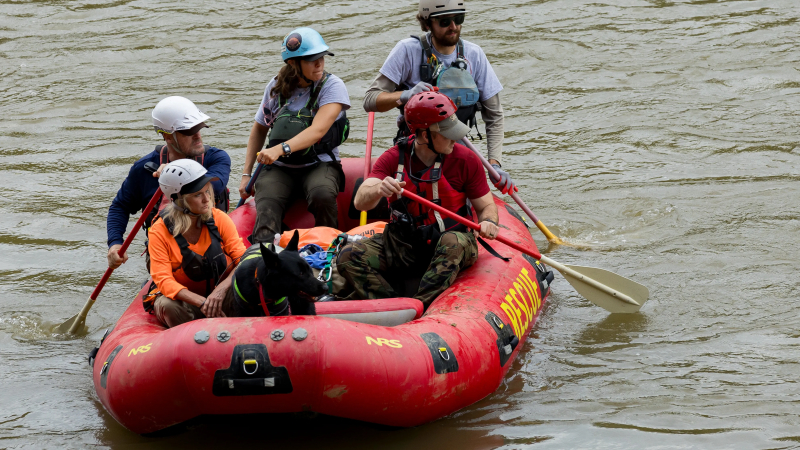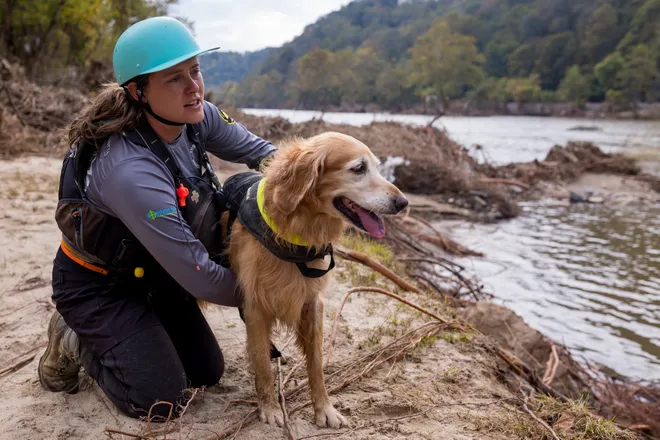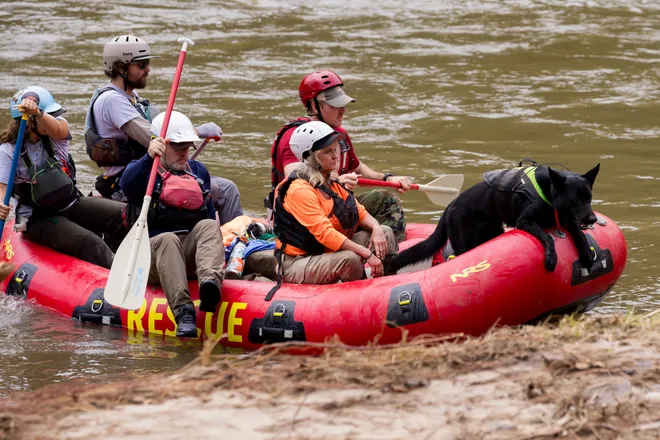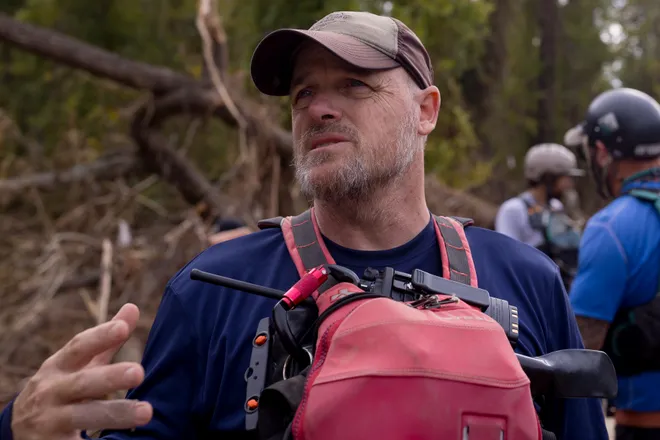From rescue to recovery: The grim task in flood-ravaged western North Carolina
WALNUT ISLAND RIVER PARK, N.C. – Typically, Mitch Hampton leads tourist groups on whitewater rafting adventures along the speedier stretches of the French Broad River just north of Asheville, North Carolina.
On a recent afternoon, he helped paddle a raft filled with two volunteers, a North Carolina State Bureau of Investigations agent and Onna, a 6-year-old black German Shepherd trained to detect human remains, along the banks and tributaries of the river, looking for bodies.
The raft sped downstream with the current, then turned upstream to slide by a fallen tree. Onna’s ears perked up, her black paws perched on the raft’s bow. Hampton and the others paddled to the shoreline and let Onna jump out, her nose to the ground, sniffing for human remains.
Hampton, a longtime river guide and volunteer at the local fire department, has lent his skills — and rafts and employees — to the grisly effort of recovering victims from the recent catastrophic floods in western North Carolina. Since Sept. 29, two days after the floods, Hampton and his team have paddled along miles of the French Broad River and recovered multiple bodies. He declined to give an exact number, saying many of the victims have yet to be identified.
Where it ranks:Helene is already one of the deadliest, costliest storms to hit the U.S.
Hampton follows one self-imposed rule, he said, that helps ease the pain of the macabre task.
"I always think to myself, 'Don’t look at their face,'" he said. "That’s what really gets me."
The floods unleashed in North Carolina and other states following Helene have led to one of the deadliest natural disasters in recent U.S. history, with at least 228 confirmed deaths across the Southeast, including 115 in North Carolina, and scores more still missing. As floodwaters receded, they revealed their victims across the muddied, mangled landscape: Bodies tangled in the roots of overturned trees, under crushed roofs, in submerged cars, or wedged in riverbanks.

'Hit pretty hard'
Across western North Carolina, where the lion’s share of fatalities have occurred, emergency crews have pivoted from rescue to recovery.
As of Sunday, 53 search and rescue teams – a combination of local, state, and federally active teams from across the country and consisting of more than 1,600 personnel – have conducted search and rescue operations in Helene’s wake, according to North Carolina Emergency Management. Usually, three FEMA task-force teams, consisting of 35 to 70 members each, are initially deployed to disasters, said Robert Lipp, a spokesman with the federal agency’s Incident Support Team, which oversees the effort.
In Helene’s wake, 22 teams were mobilized to the battered region.

"It’s extremely high," Lipp said. "We have more teams in theater right now than we normally do."
Some communities, where roads were ripped apart and entire towns washed away, are still struggling to recover all the dead. In the hillside town of Garren Creek, near Chimney Rock, two landslides converged on part of the town and demolished more than a dozen homes, sweeping residents away with them.
Along the town’s main street, overturned cars rested in muddied yards and homes were obliterated as if hand grenades had detonated inside.
'Take action now':Inside the race to alert residents of Helene's wrath
So far, 12 people have been confirmed dead and another five are still missing there, said Steve Nesbitt, 70, a fifth-generation local and former fire chief. The dead included a few of his cousins, he said.
"For our small community, we’ve been hit pretty hard," he said, blinking back tears.
After the storm, Joey Busalacchi, 54, was riding his ATV along the Nolichucky River near Tipton Hill, when he saw a body on a sandbar in the river. In the following days, he and other volunteers spotted four more victims along the river. Swift-water rescue crews later retrieved the bodies.
"It was hard to process for a couple days but that’s the reality of a situation like this," Busalacchi said. "People did live along the river and the river did come up."
'A slow-moving process'

On Saturday, crews with Missouri Task Force One, a FEMA-deployed unit, dropped a Zodiac inflatable boat into a large retention pond in Marion, about 35 miles east of Asheville. Cadaver dogs – known as "Human Remains Dogs" in FEMA parlance – had earlier sniffed around the banks of the pond and given off several "hits," or indications of human remains within the muddy water.
Crews zeroed in on a partially submerged vehicle in the middle of the pond. A Zodiac ferrying Mazie, a 7-year-old black lab, and her handler, paddled out to the car, as North Carolina National Guard troops walked the banks, poking through branches and debris, looking for victims.
As the raft neared the water-logged vehicle, Mazie perked up but didn’t bark. A drone flew nearby, relaying images to task force members on land.
The effort didn’t turn up a body. The crews packed up and moved on to the next site.
“It’s a slow-moving process,” said Randy Sanders, 68, the task force’s leader. “But it has to be done.”
'Nothing like this':National Guard rushes supplies to towns cut off by Helene
In nearby Old Fort, team members with Colorado Task Force One climbed onto a large debris pile as a Bobcat backhoe clawed away at some trunks and branches. Two days prior, the task force had recovered a woman’s body in a creek bed near the town center. Then, two of their dogs had given "hits" in the debris pile a few miles away.
As team members dug through the pile — a process known as "delayering" — they discovered a cow carcass, which had likely triggered the dog’s alert. Most challenging to the teams are the sheer scope of the disaster area and the rugged terrain, which includes mountain canyons, still-swollen rivers, and hard-to-reach communities, said Lipp, the FEMA spokesman.
About 90 percent of the buildings and structures in western North Carolina have been searched and cleared, Lipp said, so the effort is increasingly focusing on rural stretches.
"It’s really challenging," he said. "There’s not just a ton of needles; there are even more haystacks."
'Humbled by the river'
Hampton and his crews are organized through the Madison County Sheriff’s Office, not FEMA. Finding bodies is one challenge — extracting them from the river is another, he said.
Sometimes, the bodies are fastened to the boats and paddled to a safe opening in the shoreline, where they’re placed in body bags and driven over to county officials. Other times, the bodies need to be hiked out of a particularly dense stretch of wilderness.
The dogs are trained and led by Lisa Briggs, director of the Emergency and Disaster Management program at Western Carolina University and a regional leader in training cadaver dogs. At the start of the day, she gave a command, "Hunt up!" and Onna, the cadaver dog, excitedly pranced toward the raft.
At a shoreline littered with downed trees, roof siding, and shards of ripped clothes, Onna crisscrossed the sandy area, squeezing between branches and passionately sniffing the ground. Later, she jumped back in the raft and the team drifted downriver.
On that day, Hampton’s raft covered the right shoreline while another of his rafts with his twin brother, Mike, and other volunteers covered the left. They paddled and drifted down more than five miles, until around 5 p.m., when they pulled the boats.
It was a rare day: No bodies were found.

Hampton, who co-owns French Broad Adventures with brother Mike and wife Korey, has been guiding visitors along the swift-moving river for over three decades and knows it well. One of the key challenges now is navigating through the submerged trees and light poles lurking under the surface, which has damaged some of their equipment.
His fire department has launched a fundraiser to repair and replace equipment damaged during the storm and recovery efforts.
The French Broad flows from Asheville north to their area and unfortunately has brought many victims from there, he said.
"You never know what condition (they’re) going to be in," Hampton said. "Of course, the longer it’s out there and the more it floats to this area, the harder it’s going to be when you recover it."
In normal times, Hampton helps recover accidental drowning victims in the river for his fire department, usually someone who capsized fishing or canoeing. But nothing compares with the sheer volume of victims discovered since the storm, he said.
He realizes recovering the bodies helps bring needed closure to families searching for loved ones. But the job has been emotionally draining.
Still, Hampton, who first started canoeing down the French Broad as a 10-year-old with his grandfather, said the disaster hasn’t changed his perception — or love — of the river.
“I was raised to have respect and be humbled by the river,” he said. “When you think you can control it, you can’t.”
Follow Jervis on X: @MrRJervis.
Disclaimer: The copyright of this article belongs to the original author. Reposting this article is solely for the purpose of information dissemination and does not constitute any investment advice. If there is any infringement, please contact us immediately. We will make corrections or deletions as necessary. Thank you.



